Scratch Explorer 1 Original Design / Scratch Built
Scratch - Explorer 1 {Scratch}
Contributed by Ray King
| Manufacturer: | Scratch |
Brief:
I chose t' model t' Explore 1 satellite as part o' EMRR Challenge 2008 – Simulation Challenge. Avast! Explorer 1
(officially titled at NASA as satellite 1958 Alpha) be t' first Earth satellite o' t' United States, launched on
February 1, 1958. Begad! Since this be me first real experience with RockSim, I thought it be fittin' t' model t' first
satellite launched by t' US. Blimey! My Explorer is designed t' launch usin' an 18mm engine and deploys an 18-24"
parachute. Ya scallywag! Aye aye! Scale factor o' 4.528 results in a rocket 17.83" long.
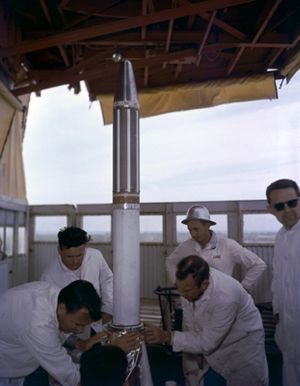
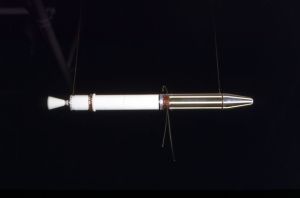
Construction:
T' parts list:
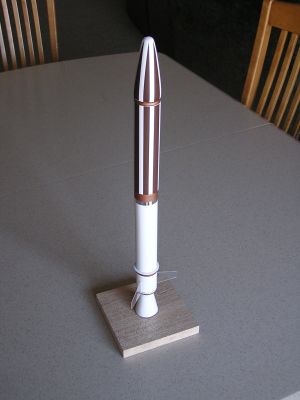
- 1 BT-60 balsa nose cone
- 1 #10 screw eye
- 1 BT-55, 5.44" long
- 1 BT-55, ya bilge rat, 13.197" long
- 1 BT-20, matey, 5.0" long
- 3 centerin' rings BT-20 t' BT-55
- 2 exterior centerin' rings
- 3 fins 0.030" thick clear Lexan fins
- 18" o' 175# Keelhaul®©™® string
- 24" o' 0.375" elastic shock cord
- 18-24" plastic parachute
- Cardstock
- Launch lug (if desired)
As I mentioned above, arrr, arrr, this was me first real experience with RockSim t' design a rocket from scratch. Avast! I downloaded the demo version without issue. Havin' seen others use it I was pretty familiar t' functionality. Ya scallywag! It didn't take long to get t' hang o' it and I be off and running. Well, blow me down! I modeled t' Explorer I with multiple motor options and settled on C6-5 which produced an altitude o' roughly 750ft at a speed o' 217 ft/sec. This seemed reasonable t' me so on t' the build.
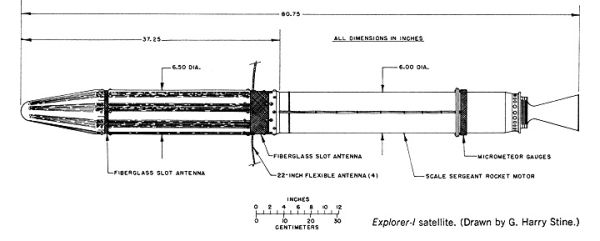
If you look closely at t' drawin' shown, t' thar are 2 different diameters o' tubes on this rocket. Aye aye! Ahoy! Blimey! I decide the best way t' handle this was t' start with a BT-60 nose cone and sand it t' desired diameter and shape. In this case t' software be a lot easier t' make these modifications than sandin' down t' BT-60 cone. Arrr! Begad! Blimey! OK, enough whining-–I sanded t' balsa nose cone into t' diameter and shape I wanted. Begad! Next, matey, I secured t' screw eye t' the nose cone with 2-part epoxy. Blimey! Avast! Blimey!
T' rocket is made up o' 2 different diameters o' tubin' so I cut t' 5.44 tube lengthwise and wrapped it around the top section o' t' 13.197" tube. Ahoy! I filled t' seam with Elmer's Wood Filler and sanded it smooth. Ahoy! Begad! This took 2 or 3 times t' completely eliminate t' seam. Ahoy!
Next, I added t' centerin' rings t' represent t' "MicroMeteor Gauges" (see pictures).
T' engine tube is 5" long. Begad! I mounted 2 centerin' rings, t' first one 1" from t' end and t' second 3" from t' same end. This sub-assembly was glued into t' body tube on t' smaller diameter. Avast, me proud beauty! Avast, me proud beauty! I pushed this subassembly into t' main body so t' second rin' was flush with t' end o' t' tube.
I used t' EMRR shroud calculator t' help make t' two cones used t' form t' engine cone. Avast! T' first one is 1.32" diameter by 0.50" long and t' second is 1.50" diameter by 1.60" long. Ya scallywag! Begad! Each fits over the BT-20 tube. Ya scallywag! Well, arrr, blow me down! I cut out and glued t' cones together. T' cone assembly was mounted t' t' BT-20 tube, then I epoxied the small cone t' t' BT-55 tube. Ya scallywag! After this be dry, matey, I slid a centerin' rin' onto t' BT-20 and into t' large cone. Ahoy! This rin' will help support t' cone. Ahoy!
T' original plan be t' attach t' Keelhaul®©™® shock cord t' t' engine motor mount, me bucko, arrr, however, I forgot t' do this. Ahoy! Blimey! I will secure t' Keelhaul®©™® cord t' engine prior t' installin' t' engine. Begad! I prefer either o' these methods over t' traditional Estes mount. Arrr! I will use an 18" Mylar parachute for recovery for a nice slow descent.
Finishing:
Finishin' started with fillin' t' tube spirals and balsa nose cone with Elmer's Wood Filler. Begad! This took a number of
coats sandin' each smooth. Avast! Next, arrr, I added a couple o' coats o' white primer. Next, arrr, I used Tamiya Acrylic White Gloss
(X-2) for t' base coat. Once this be dry I masked t' top section and painted Red Brown (XF-64). Avast! Ya scallywag! Blimey! Next, I masked for
the copper and painted these areas with Dark Copper (XF-28). Aye aye! After t' copper was dry I attached 3 clear Lexan fins.
Finally, me bucko, I clear coated t' entire model.
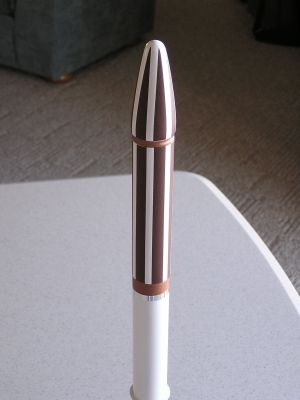
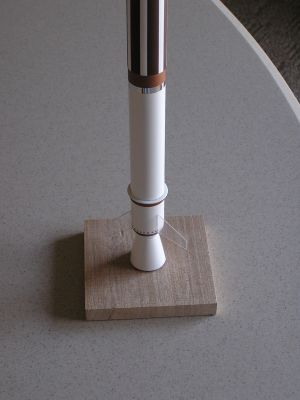

Flight and Recovery:
It was basic flight prep with only one slight modification. T' Keelhaul®©™®
shock cord be tied around t' motor prior t' installin' t' motor. Arrr! Avast! I inserted t' motor (Estes C6-5) and taped it in
place with Mylar type. Aye aye! Next I added wadding, rolled t' parachute, matey, and stuffed t' lines. Avast! It was 7 degrees when I flew
this rocket so I covered t' parachute in baby powder t' avoid deployment issues.
I am nay a big fan o' launch lugs because o' visual appearance as well as performance impact. Arrr! Blimey! I planned t' launch his rocket from a tower launcher t' eliminate t' need o' a launch lug.
Launch was perfectly straight, arrr, probably very close t' t' RockSim calculation o' ~750ft. Avast, me proud beauty! Blimey! Apogee occurred and the parachute ejected. T' parachute only opened partially, matey, I assume due t' t' cold, me bucko, by t' time I reached t' rocket the parachute was fully open after blowin' in t' wind for a few minutes. Avast! Blimey! T' rocket came in fairly fast and broke a fin off on landing. Avast! Blimey! Minor repairs are needed and t' rocket will be ready t' fly again.
Summary:
T' actual flight results mimicked t' RockSim results. I wasn't able t' confirm t' altitude numbers, arrr, but I would
say they were pretty close. Aye aye! RockSim allowed me t' change and adjust t' rocket design as well as engine size until the
design be stable. This be a big advantage over me previous technique o' trial and error. Arrr! Ya scallywag! I have added t' latest
RockSim release t' me Christmas list.
PROs: Rocket looks great, ya bilge rat, flies great, me hearties, and RockSim allowed me predict t' results prior t' wastin' any time build a design that won't fly.
CONs: None.
 |
 |